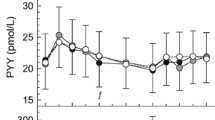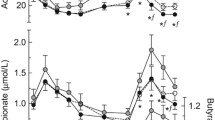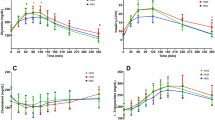Abstract
Purpose
To test the hypothesis that oral ingestion of slowly digestible carbohydrates (SDCs) that reach the ileum triggers the ileal brake as indicated by delayed gastric emptying, reduced glycemic response, and decreased subjective appetite.
Methods
The study was a five-arm, randomized, double-blind, crossover trial with a 1-week washout period between treatments (n = 20; 9 females, 11 males). Five treatments consisted of three SDC ingredients [raw corn starch, isomaltooligosaccharide (IMO), sucromalt], and an IMO/sucromalt combination, shown in vitro to have slow and extended digestion profiles, and a rapidly digestible carbohydrate control (maltodextrin). Carbohydrates (26 g) were incorporated into yogurt [300 g total; carbohydrate (~ 77 g), fat (~ 0.2 g), and protein (~ 9 g)] with closely matched energy content (346 kcal) and viscosity (~ 30,000 cP). Outcomes were measured in a 4 h postprandial period.
Results
Mean gastric half-emptying times were moderately though significantly increased for the raw corn starch and IMO treatments (P < 0.05), but they could be sub-divided into larger effect responder (n = 11) and non-responder groups (n = 9). Longer time for glycemic response to return to baseline was associated with increased gastric half-emptying time in an exploratory subset of data removing gastric half-emptying times > 3.5 h (P = 0.02). No significant differences in appetite ratings were observed.
Conclusion
SDCs caused slower gastric emptying rate through activation of the ileal brake, as closely matched semi-solid yogurts were used and only rate of carbohydrate digestion differed. Extending glycemic response through consumption of SDCs was associated with triggering the ileal brake.
Trial registration
ClinicalTrials.gov NCT03630445, August 2018, retrospectively registered.









Similar content being viewed by others
Abbreviations
- AUC:
-
Area under the curve
- BMI:
-
Body mass index
- CGM:
-
Continuous glucose monitoring
- CPDR:
-
Cumulative percent dose recovery
- DOB:
-
Delta over baseline
- GLP-1:
-
Glucagon-like peptide-1
- IMO:
-
Isomaltooligosaccharide
- PDR:
-
Percent dose recovery
- PYY:
-
Peptide tyrosine tyrosine
- RDC:
-
Rapidly digestible carbohydrate
- SDC:
-
Slowly digestible carbohydrate
- VAS:
-
Visual analog scale
References
Hasek LY, Phillips RJ, Zhang G et al (2018) Dietary slowly digestible starch triggers the gut-brain axis in obese rats with accompanied reduced food intake. Mol Nutr Food Res 62:1700117. https://doi.org/10.1002/mnfr.201700117
Hasek LY, Phillips RJ, Hayes AMR et al (2020) Carbohydrates designed with different digestion rates modulate gastric emptying response in rats. Int J Food Sci Nutr 71:839–844. https://doi.org/10.1080/09637486.2020.1738355
Maljaars PWJ, Peters HPF, Mela DJ, Masclee AAM (2008) Ileal brake: A sensible food target for appetite control. A review. Physiol Behav 95:271–281. https://doi.org/10.1016/j.physbeh.2008.07.018
Alleleyn A, van Avesaat M, Troost F, Masclee A (2016) Gastrointestinal nutrient infusion site and eating behavior: Evidence for a proximal to distal gradient within the small intestine? Nutrients 8:117. https://doi.org/10.3390/nu8030117
Spiller RC, Trotman IF, Adrian TE et al (1988) Further characterisation of the “ileal brake” reflex in man–effect of ileal infusion of partial digests of fat, protein, and starch on jejunal motility and release of neurotensin, enteroglucagon, and peptide YY. Gut 29:1042–1051. https://doi.org/10.1136/gut.29.8.1042
Strader AD, Woods SC (2005) Gastrointestinal hormones and food intake. Gastroenterology 128:175–191. https://doi.org/10.1053/j.gastro.2004.10.043
Spreckley E (2015) The L-cell in nutritional sensing and the regulation of appetite. Front Nutr. https://doi.org/10.3389/fnut.2015.00023
Schirra J, Göke B (2005) The physiological role of GLP-1 in human: Incretin, ileal brake or more? Regul Pept 128:109–115. https://doi.org/10.1016/j.regpep.2004.06.018
Poppitt SD, Shin HS, McGill AT et al (2017) Duodenal and ileal glucose infusions differentially alter gastrointestinal peptides, appetite response, and food intake: A tube feeding study. Am J Clin Nutr 106:725–735. https://doi.org/10.3945/ajcn.117.157248
Holgate AM, Read NW (1985) Effect of ileal infusion of intralipid on gastrointestinal transit, ileal flow rate, and carbohydrate absorption in humans after ingestion of a liquid meal. Gastroenterology 88:1005–1011. https://doi.org/10.1016/S0016-5085(85)80021-4
Pironi L, Stanghellini V, Miglioli M et al (1993) Fat-induced ileal brake in humans: A dose-dependent phenomenon correlated to the plasma levels of peptide YY. Gastroenterology 105:733–739. https://doi.org/10.1016/0016-5085(93)90890-O
Jain NK, Boivin M, Zinsmeister a R, DiMagno EP, (1991) The ileum and carbohydrate-mediated feedback regulation of postprandial pancreaticobiliary secretion in normal humans. Pancreas 6:495–505
Zhang G, Ao Z, Hamaker BR (2006) Slow digestion property of native cereal starches. Biomacromol 7:3252–3258. https://doi.org/10.1021/bm060342i
Zhang G, Venkatachalam M, Hamaker BR (2006) Structural basis for the slow digestion property of native cereal starches. Biomacromol 7:3259–3266. https://doi.org/10.1021/bm060343a
Komuro Y, Kondo T, Hino S et al (2020) Oral intake of slowly digestible α-glucan, isomaltodextrin, stimulates glucagon-like peptide-1 secretion in the small intestine of rats. Br J Nutr 123:619–626. https://doi.org/10.1017/S0007114519003210
Oku T, Nakamura S (2003) Comparison of digestibility and breath hydrogen gas excretion of fructo-oligosaccharide, galactosyl-sucrose, and isomalto-oligosaccharide in healthy human subjects. Eur J Clin Nutr 57:1150–1156. https://doi.org/10.1038/sj.ejcn.1601666
Grysman A, Carlson T, Wolever TMS (2008) Effects of sucromalt on postprandial responses in human subjects. Eur J Clin Nutr 62:1364–1371. https://doi.org/10.1038/sj.ejcn.1602890
Lim J, Kim DK, Shin H et al (2019) Different inhibition properties of catechins on the individual subunits of mucosal α-glucosidases as measured by partially-purified rat intestinal extract. Food Funct 10:4407–4413. https://doi.org/10.1039/C9FO00990F
Sanaka M, Yamamoto T, Anjiki H et al (2007) Effects of agar and pectin on gastric emptying and post-prandial glycaemic profiles in healthy human volunteers. Clin Exp Pharmacol Physiol 34:1151–1155
Sanaka M, Nakada K (2010) Stable isotope breath tests for assessing gastric emptying: A comprehensive review. J Smooth Muscle Res 46:267–280
Ghoos YF, Maes BD, Geypens BJ et al (1993) Measurement of gastric emptying rate of solids by means of a carbon-labeled octanoic acid breath test. Gastroenterology 104:1640–1647. https://doi.org/10.1016/0016-5085(93)90640-X
Haycock GB, Schwartz GJ, Wisotsky DH (1978) Geometric method for measuring body surface area: A height-weight formula validated in infants, children, and adults. J Pediatr 93:62–66. https://doi.org/10.1016/S0022-3476(78)80601-5
Cisse F, Erickson DP, Hayes AMR et al (2018) Traditional Malian solid foods made from sorghum and millet have markedly slower gastric emptying than rice, potato, or pasta. Nutrients 10:124. https://doi.org/10.3390/nu10020124
Cisse F, Pletsch EA, Erickson DP et al (2017) Preload of slowly digestible carbohydrate microspheres decreases gastric emptying rate of subsequent meal in humans. Nutr Res 45:46–51. https://doi.org/10.1016/j.nutres.2017.06.009
Pletsch EA, Hamaker BR (2018) Brown rice compared to white rice slows gastric emptying in humans. Eur J Clin Nutr 72:367–373. https://doi.org/10.1038/s41430-017-0003-z
Hayes AMR, Gozzi F, Diatta A et al (2021) Some pearl millet-based foods promote satiety or reduce glycaemic response in a crossover trial. Br J Nutr 126:1168–1178. https://doi.org/10.1017/S0007114520005036
Perri F, Pastore MR, Annese V (2005) 13C-octanoic acid breath test for measuring gastric emptying of solids. Eur Rev Med Pharmacol Sci 9:3–8
Flint A, Raben A, Blundell JE, Astrup A (2000) Reproducibility, power and validity of visual analogue scales in assessment of appetite sensations in single test meal studies. Int J Obes 24:38–48
Cassady BA, Considine RV, Mattes RD (2012) Beverage consumption, appetite, and energy intake: what did you expect? Am J Clin Nutr 95:587–593. https://doi.org/10.3945/ajcn.111.025437
Alfenas R, Mattes R (2005) Influence of glycemic index/load on glycemic response, appetite, and food. Diabetes Care 28:2123–2129
Vonk RJ, Hagedoorn RE, de Graaff R et al (2000) Digestion of so-called resistant starch sources in the human small intestine. Am J Clin Nutr 72:432–438
Dammann KW, Bell M, Kanter M, Berger A (2013) Effects of consumption of sucromalt, a slowly digestible carbohydrate, on mental and physical energy questionnaire responses. Nutr Neurosci 16:83–95. https://doi.org/10.1179/1476830512Y.0000000034
Williams JW, Zimmet PZ, Shaw JE et al (2003) Gender differences in the prevalence of impaired fasting glycaemia and impaired glucose tolerance in Mauritius. Does sex matter? Diabet Med 20:915–920. https://doi.org/10.1046/j.1464-5491.2003.01059.x
Sicree RA, Zimmet PZ, Dunstan DW et al (2008) Differences in height explain gender differences in the response to the oral glucose tolerance test— the AusDiab study. Diabet Med 25:296–302. https://doi.org/10.1111/j.1464-5491.2007.02362.x
The DECODE Study Group (2003) Age- and Sex-Specific Prevalences of Diabetes and Impaired Glucose Regulation in 13 European Cohorts. Diabetes Care 26:61–69. https://doi.org/10.2337/diacare.26.1.61
Kautzky-Willer A, Brazzale AR, Moro E et al (2012) Influence of Increasing BMI on Insulin Sensitivity and Secretion in Normotolerant Men and Women of a Wide Age Span. Obesity 20:1966–1973. https://doi.org/10.1038/oby.2011.384
Tramunt B, Smati S, Grandgeorge N et al (2020) Sex differences in metabolic regulation and diabetes susceptibility. Diabetologia 63:453–461. https://doi.org/10.1007/s00125-019-05040-3
Zhou B, Lu Y, Hajifathalian K et al (2016) Worldwide trends in diabetes since 1980: a pooled analysis of 751 population-based studies with 4·4 million participants. Lancet 387:1513–1530. https://doi.org/10.1016/S0140-6736(16)00618-8
Blaak E (2008) Sex differences in the control of glucose homeostasis. Curr Opin Clin Nutr Metab Care 11:500–504. https://doi.org/10.1097/MCO.0b013e32830467d3
Palmu S, Kuneinen S, Kautiainen H et al (2021) Body surface area may explain sex differences in findings from the oral glucose tolerance test among subjects with normal glucose tolerance. Nutr Metab Cardiovasc Dis 31:2678–2684. https://doi.org/10.1016/j.numecd.2021.05.018
Konturek S, Konturek J, Pawlik T, Brzoowki T (2004) Brain-gut axis and its role in the control of food intake. J Physiol Pharmacol 55:137–154
Murphy KG, Bloom SR (2006) Gut hormones and the regulation of energy homeostasis. Nature 444:854–859. https://doi.org/10.1038/nature05484
Siegle ML, Schmid HR, Ehrlein HJ (1990) Effects of ileal infusions of nutrients on motor patterns of canine small intestine. Am J Physiol Liver Physiol 259:G78–G85. https://doi.org/10.1152/ajpgi.1990.259.1.G78
Lin HC, Kim BH, Elashoff JD et al (1992) Gastric emptying of solid food is most potently inhibited by carbohydrate in the canine distal ileum. Gastroenterology 102:793–801
Layer P, Peschel S, Schlesinger T, Goebell H (1990) Human pancreatic secretion and intestinal motility: effects of ileal nutrient perfusion. Am J Physiol 258:G196-201. https://doi.org/10.1152/ajpgi.1990.258.2.G196
Rigda RS, Trahair LG, Little TJ et al (2016) Regional specificity of the gut-incretin response to small intestinal glucose infusion in healthy older subjects. Peptides 86:126–132. https://doi.org/10.1016/j.peptides.2016.10.010
Gottfried-Blackmore A, Adler EP, Fernandez-Becker N et al (2020) Open-label pilot study: Non-invasive vagal nerve stimulation improves symptoms and gastric emptying in patients with idiopathic gastroparesis. Neurogastroenterol Motil. https://doi.org/10.1111/nmo.13769
Walker S, Meinke J, Klotz U et al (1990) Gastric emptying in non-responders to H2-receptor antagonists. Klin Wochenschr 68:959–963. https://doi.org/10.1007/BF01646654
Clegg M, Shafat A (2010) Gastric emptying and orocaecal transit time of meals containing lactulose or inulin in men. Br J Nutr 104:554–559. https://doi.org/10.1017/S0007114510000905
Zojaji H, Ataei E, Sherafat SJ et al (2013) The effect of the treatment of Helicobacter pylori infection on the glycemic control in type 2 diabetes mellitus. Gastroenterol Hepatol Bed Bench 6:36–40
Hayes AMR, Swackhamer C, Mennah-Govela YA et al (2020) Pearl millet (Pennisetum glaucum) couscous breaks down faster than wheat couscous in the Human Gastric Simulator, though has slower starch hydrolysis. Food Funct 11:111–122. https://doi.org/10.1039/C9FO01461F
Alyami J, Ladd N, Pritchard SE et al (2019) Glycaemic, gastrointestinal and appetite responses to breakfast porridges from ancient cereal grains: A MRI pilot study in healthy humans. Food Res Int 118:49–57. https://doi.org/10.1016/j.foodres.2017.11.071
Sandhu KS, Siroha AK (2017) Relationships between physicochemical, thermal, rheological and in vitro digestibility properties of starches from pearl millet cultivars. LWT Food Sci Technol 83:213–224. https://doi.org/10.1016/j.lwt.2017.05.015
Brennan IM, Feltrin KL, Nair NS et al (2009) Effects of the phases of the menstrual cycle on gastric emptying, glycemia, plasma GLP-1 and insulin, and energy intake in healthy lean women. Am J Physiol Liver Physiol 297:G602–G610. https://doi.org/10.1152/ajpgi.00051.2009
Campolier M, Thondre SP, Clegg M et al (2016) Changes in PYY and gastric emptying across the phases of the menstrual cycle and the influence of the ovarian hormones. Appetite 107:106–115. https://doi.org/10.1016/j.appet.2016.07.027
Horowitz M, Cunningham KM, Wishart JM et al (1996) The effect of short-term dietary supplementation with glucose on gastric emptying of glucose and fructose and oral glucose tolerance in normal subjects. Diabetologia 39:481–486. https://doi.org/10.1007/BF00400681
Castiglione KE, Read NW, French SJ (2002) Adaptation to high-fat diet accelerates emptying of fat but not carbohydrate test meals in humans. Am J Physiol Integr Comp Physiol 282:R366–R371. https://doi.org/10.1152/ajpregu.00190.2001
Author information
Authors and Affiliations
Contributions
MC: conceptualization, formal analysis, investigation, writing—original draft. AMRH: formal analysis, investigation, writing—original draft, writing—review and editing, visualization. TDG: conceptualization, methodology, formal analysis, resources. MMM: methodology, resources, writing—review and editing. JL: investigation. RSM: conceptualization, writing—review and editing. NMH: methodology, formal analysis. MEH: resources. BRH: conceptualization, methodology, resources, writing—original draft, writing—review and editing, project administration, funding acquisition. All authors read and approved the final manuscript.
Corresponding author
Ethics declarations
Conflict of interest
TDG, MMM, RSM, NMH, and MEH were employed at General Mills, Inc. when the study was conducted. MC, AMRH, JL, and BRH report no conflict of interest to the study.
Ethical approval
All procedures were conducted in accordance with the ethical standards of the Purdue University Institutional Review Board (Protocol #1502015807) and the study was registered at ClinicalTrials.gov (NCT03630445).
Consent to participate
Written informed consent was provided by all participants prior to their inclusion in the study.
Consent for publication
The authors affirm that human research participants acknowledged consent for publication of the current study.
Supplementary Information
Below is the link to the electronic supplementary material.
Rights and permissions
About this article
Cite this article
Chegeni, M., Hayes, A.M.R., Gonzalez, T.D. et al. Activation of gastrointestinal ileal brake response with dietary slowly digestible carbohydrates, with no observed effect on subjective appetite, in an acute randomized, double-blind, crossover trial. Eur J Nutr 61, 1965–1980 (2022). https://doi.org/10.1007/s00394-021-02770-2
Received:
Accepted:
Published:
Issue Date:
DOI: https://doi.org/10.1007/s00394-021-02770-2




